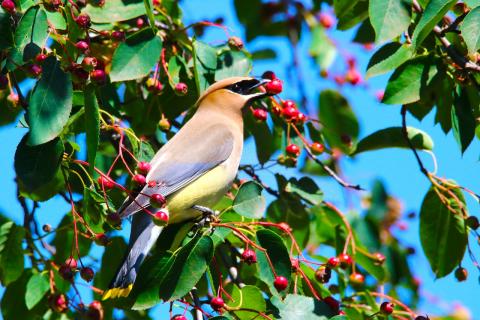Looking for Serviceberry

I recently visited a property to look at an exceptionally large specimen of serviceberry. This plant normally is a shrub or small tree, generally not getting much larger than four or five inches in diameter. This one had reached medium size tree status.
Serviceberry, genus Amelanchier, is a member of the rose family. According to legend, it's called serviceberry because it blooms in early spring, when the ground thaws and the first funeral service can be held after the long frozen winter when no graves could be dug. Another name for serviceberry is shadbush. This name has to do with the spring shad runs coinciding with the flowering of the plant. Shad are a fish of the herring family that, similar to salmon, live in saltwater then swim into freshwater rivers to spawn. The Connecticut River hosts a shad run every spring. (It’s interesting that large numbers of fish swimming up a river is a called a “run." But that’s a different story.)
The serviceberry has white flowers in the early spring, and is one of the first trees and shrubs to bloom. Small red/purple berries ripen from June to August. These berries can be eaten raw and reportedly taste similar to blueberries. (I’ve never tried them myself, but I will now.) They can also be baked in pies, muffins, and pastries, made into jam, or fermented into wine. The berries are very popular with songbirds, with 40 or more species known to feed on them, along with squirrels, mice, and other rodents, rabbits, fox, bears, and deer.
In addition to the beautiful white flowers and the tasty fruit, the leaves of the serviceberry turn orange in autumn, providing a show of color before the leaves fall.
Since the serviceberry typically doesn’t grow very large, its wood isn't commonly used. It was used occasionally for tool handles due to its hardness and density, and the saplings were valued by Cree Indians for arrow making. Today, its highest value is the beauty of its flowers and foliage, and the usefulness of the fruit for wildlife and people.
If you’re looking to plant a tree or shrub on your property, consider the serviceberry. It will give you beautiful spring flowers, edible fruit for you and wildlife, and colors in the fall. If you’re working in your woods and come across some wild serviceberry, give them some room by cutting trees that are competing with them. This will allow more sun to reach the crown, resulting in more fruit for wildlife.
The large serviceberry at the beginning of the article may be a candidate for the largest one in Grafton County. It will be submitted to the N.H. Big Tree Program, which recognizes the largest known trees in each county, as well as statewide. If you know of a particularly large specimen of a tree, and suspect it might be a champion, you can nominate it as a candidate for consideration. For more information visit the NH Big Tree Program.
Sources: The Amazing Serviceberry, by Nan K. Chase in Mother Earth News NRCS Plant Guide - Downy Serviceberry. By Guy Nesom. USDA NRCS National Plant Data Center and Biota of North America Program.